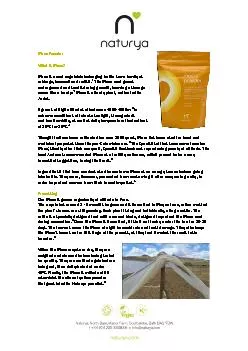

Maca Powder What is Maca Maca cabbage broccoli and radish 1 The Maca root grows underground and swells during growth forming a storage ocean like a turnip 2 Maca is a hardy plant native ID: 852416
Download Pdf The PPT/PDF document "is a root vegetable belonging to the sam..." is the property of its rightful owner. Permission is granted to download and print the materials on this web site for personal, non-commercial use only, and to display it on your personal computer provided you do not modify the materials and that you retain all copyright notices contained in the materials. By downloading content from our website, you accept the terms of this agreement.
1 Maca Powder What is Maca ? Ma
Maca Powder What is Maca ? Maca is a root vegetable belonging to the same family as cabbage, broccoli and radish. 1 The Maca root grows underground and swells during growth, forming a storage ocean like a turnip. 2 Maca is a hardy plant, native to the Andes. It grows at high altitudes of between 4000 - 4500m 3 in extreme conditions of intense sunlight, strong winds and low humidity, as well as daily temperature fluctuations of 20°C to - 1 0°C. 4 Thought to have been cultivated for over 2000 years, Maca has been used for food and medicinal purposes since the pre - Columbian era. 5 The Spanish settlers soon came to value Maca ; shortly after their conquest, Spanish livestock was reproducing poorl y at altitude. The local Andeans recommended Maca as a fertility enhancer, which proved to be a very successful suggestion, saving the herds. 6 Legend has it that Inca warriors used to consume Maca as an energy source before going into battle. They were, h owever, prevented from consuming it after conquering a city, in order to protect women from their sexual impulses. 7 Processing Our Maca is grown organically at altitude in Peru. The crop takes around 8 - 9 months to grow and is harvested in May or June, when most of the plantâs leaves are still growing. Each plant is dug out individually, using a cashu. The cashu is a specially designed tool with a curved blade, designed to protect the Maca root during excavation. 3 Once the Maca is harvested, it is left o ut to dry under the sun for 10 - 15 days. The farmers cover the Maca at night to avoid rain and frost damage. They also keep the Maca 's leaves on for this stage of the process, as they feel it makes the roots taste sweeter. 3 When the Maca crops are dry, the y are weighed and cleaned before being sorted for quality. They are washed again before being cut, then dehydrated at under 45°C. Finally, the Maca is milled until it resembles the vibrant yellow powder that goes into the Naturya pouches. 3
2 How to enjoy Maca Maca has b
How to enjoy Maca Maca has been used as an ingredient for centuries. The most common use for Maca is to throw it into a blender with a heap of other ingredients and create a smoothie. Itâs perfect as part of a breakfast blend, a post - workout shake, or an antioxidant smoothie. Great with cacao, Maca tastes lovely in a warm drink during those long winter evenings. If youâre feeling peckish and a drink wonât suffice then Maca can be stirred into yoghur t, or combined with a spread to slaver over toast. Maca is a useful baking ingredient and can be used in all kinds of dessert recipes, from cookies to brownies and everything in between! The Science Naturya Organic Maca Powder science information is currently being updated 1 B.M. Ley, 2003. Maca ! Peruvian ginseng â the hormonal regulator. BL Publications. 2 M. Hermann & J. Heller, 1997. Promoting the conservation and use of underutilized and neglected crops. A ndean roots and tubers: Ahipa, arracacha, Maca and yacon. International Plant Genetic Resources Institute. 3 Supplier pers. comms. 4 R. Repo - Carrasco - Valencia, 2011. Andean Indigenous Food Crops: Nutritional Value and Bioactive Compounds. (Doctoral Thesis) Department of Biochemistry and Food Chemistry, University of Turku. 5 E. Esparza, W. Kofer, Y. Bendezú, G. Gonzales & E. Cosio. Fast analysis of Maca bioactive compounds for ecotype characterization and export quality control. International Society for Tropical Root Crops. 6 Ad Hoc Panel of the Advisory Committee on Technology Innovation, Board on Science and Technology for International Development, N ational Research Council, 1989. Lost Crops of the Incas: Little - Known Plants of the Andes with Promise for Worldwide Cultivation. Washington DC: The National Academies Press. 7 M.Stone, A. Ibarra, M. Roller, A. Zangara & E. Stevenson, 2009. A pilot investi gation into the effect of Maca supplementation on physical activity and sexual desire in sportsmen. Journal of Ethnopharmacology